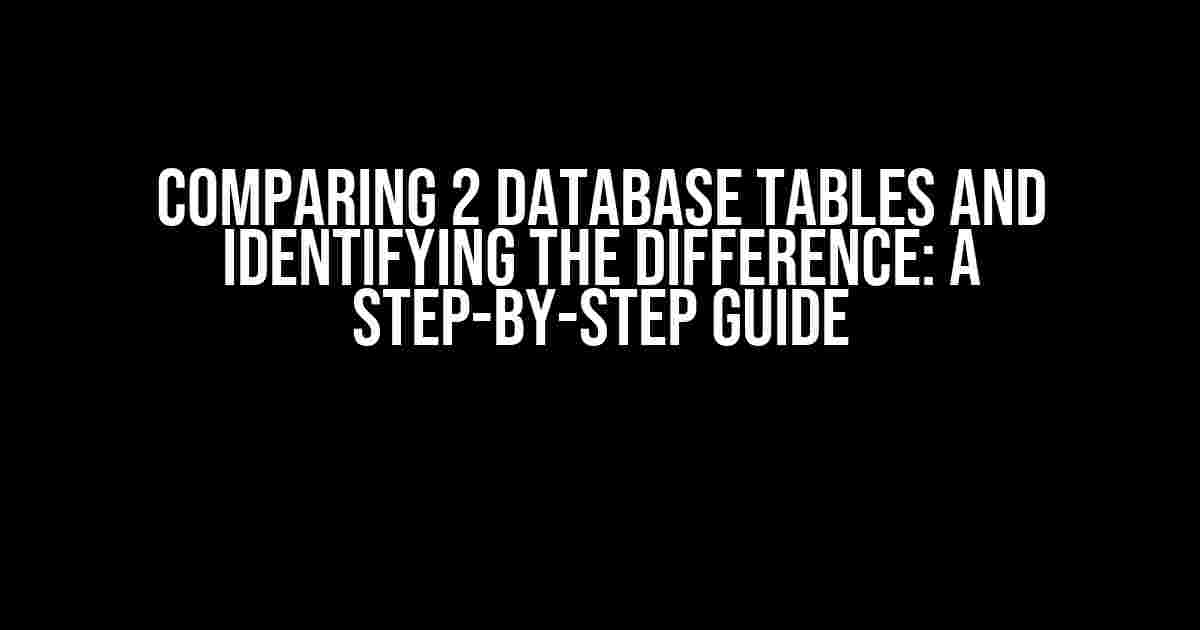Are you tired of manually sifting through rows and columns to find the differences between two database tables? Do you wish there was a more efficient way to identify the discrepancies between two seemingly identical tables? Well, you’re in luck! In this article, we’ll take you on a journey to explore the world of database table comparison and show you how to compare 2 database tables and identify the differences with ease.
Why Compare Database Tables?
Before we dive into the nitty-gritty of comparing database tables, let’s take a step back and understand why comparing tables is essential in the first place. Here are a few reasons why comparing database tables is crucial:
- Data Integrity**: Comparing database tables helps ensure data integrity by identifying inconsistencies and discrepancies between tables.
- Data Validation**: Comparing tables helps validate data by checking for errors, omissions, or inconsistencies.
- Optimization**: Comparing tables can help optimize database performance by identifying redundant or unnecessary data.
- Troubleshooting**: Comparing tables can aid in troubleshooting issues by identifying the root cause of errors or anomalies.
Preparation is Key: Understanding the Database Environment
Before comparing database tables, it’s essential to understand the database environment and prepare the necessary tools and resources. Here are a few things to keep in mind:
Database Management System (DBMS)**: Identify the DBMS used to create and manage the database, such as MySQL, PostgreSQL, or Microsoft SQL Server.
Database Schema**: Familiarize yourself with the database schema, including the table structures, relationships, and constraints.
Database Tooling**: Choose a suitable database tool or client, such as phpMyAdmin, SQL Server Management Studio, or pgAdmin, to interact with the database.
Comparing Database Tables: A Step-by-Step Approach
Now that we’ve covered the importance of comparing database tables and prepared the necessary resources, let’s dive into the step-by-step process of comparing two database tables and identifying the differences:
Step 1: Identify the Tables to Compare
Identify the two tables you want to compare. Let’s assume we’re comparing two tables, table_A and table_B, in a database named mydatabase.
mydatabase table_A id | name | email ----|-------|------ 1 | John | [email protected] 2 | Jane | [email protected] 3 | Joe | [email protected] table_B id | name | email ----|-------|------ 1 | John | [email protected] 2 | Jane | [email protected] 3 | Joe | [email protected]
Step 2: Extract the Table Structures
Extract the table structures, including the column names and data types, using the following query:
SHOW COLUMNS FROM table_A; SHOW COLUMNS FROM table_B;
This will return the table structures, including the column names, data types, and other attributes:
table_A Field | Type | Null | Key | Default | Extra ------|-------------|------|-----|---------|------- id | int(11) | NO | PRI | NULL | auto_increment name | varchar(50) | YES | | NULL | email | varchar(100)| YES | | NULL | table_B Field | Type | Null | Key | Default | Extra ------|-------------|------|-----|---------|------- id | int(11) | NO | PRI | NULL | auto_increment name | varchar(50) | YES | | NULL | email | varchar(100)| YES | | NULL |
Step 3: Compare the Table Structures
Compare the table structures to identify any differences in column names, data types, or other attributes. In this example, the table structures are identical, but in a real-world scenario, you may encounter differences:
table_A and table_B have identical table structures
Step 4: Extract the Data
Extract the data from both tables using the following query:
SELECT * FROM table_A; SELECT * FROM table_B;
This will return the data from both tables:
table_A id | name | email ----|-------|------ 1 | John | [email protected] 2 | Jane | [email protected] 3 | Joe | [email protected] table_B id | name | email ----|-------|------ 1 | John | [email protected] 2 | Jane | [email protected] 3 | Joe | [email protected]
Step 5: Compare the Data
Compare the data from both tables to identify any differences. You can use various methods, such as:
- Visual inspection: Manually compare the data from both tables to identify differences.
- SQL queries: Use SQL queries to compare the data, such as using the
EXCEPTorNOT INoperators. - Database tools: Utilize database tools, such as data comparison software, to automate the comparison process.
In this example, we can use a simple SQL query to identify the differences:
SELECT * FROM table_A EXCEPT SELECT * FROM table_B;
This will return the differences between the two tables:
id | name | email ----|-------|------ 2 | Jane | [email protected] 3 | Joe | [email protected]
Step 6: Analyze and Interpret the Results
Analyze and interpret the results to understand the nature of the differences between the two tables. In this example, we can see that:
- Jane’s email address is different between the two tables.
- Joe’s email address is different between the two tables.
Conclusion
Comparing database tables is an essential task that helps ensure data integrity, validate data, optimize database performance, and troubleshoot issues. By following the step-by-step approach outlined in this article, you can easily compare two database tables and identify the differences.
Remember to prepare the necessary resources, understand the database environment, and choose the right tools and methods to compare the tables. With practice and patience, you’ll become a pro at comparing database tables and identifying the differences in no time!
Additional Resources
For further reading and resources on comparing database tables, check out the following:
- W3Schools: SQL Compare
- Stack Overflow: Comparing Database Tables
- Database Journal: Comparing Database Tables
Frequently Asked Question
When it comes to database management, one of the most crucial tasks is comparing two database tables and identifying the differences. This process can be daunting, but don’t worry, we’ve got you covered! Here are some frequently asked questions and answers to help you master this task.
What is the purpose of comparing two database tables?
Comparing two database tables helps identify discrepancies, errors, or inconsistencies between the two datasets. This process ensures data integrity, accuracy, and reliability, which is essential for making informed business decisions or troubleshooting issues.
What are the different types of differences that can exist between two database tables?
There are three types of differences that can exist between two database tables: structural differences (e.g., differences in table schema or column names), data differences (e.g., different values or records), and metadata differences (e.g., differences in indexing or constraints).
How do I compare two database tables manually?
To compare two database tables manually, you can use SQL queries to extract data from each table and then compare the results using tools like Excel or a data comparison tool. Alternatively, you can use database management tools like SQL Server Management Studio or MySQL Workbench to visualize and compare the table structures and data.
What are some automated tools for comparing database tables?
There are several automated tools available for comparing database tables, including Apex Data Diff, SQL Data Compare, and dbForge Data Compare. These tools can save you time and effort by automatically identifying differences between tables, generating synchronization scripts, and providing detailed reports.
How often should I compare database tables?
The frequency of comparing database tables depends on the nature of your database and the type of data it contains. As a general rule, it’s recommended to compare database tables regularly, such as during database maintenance, after data migrations, or when troubleshooting issues.


